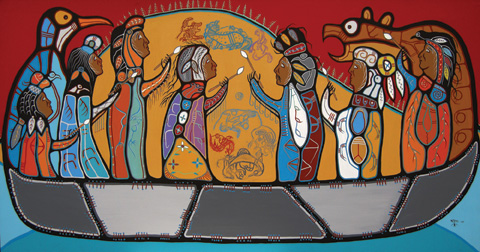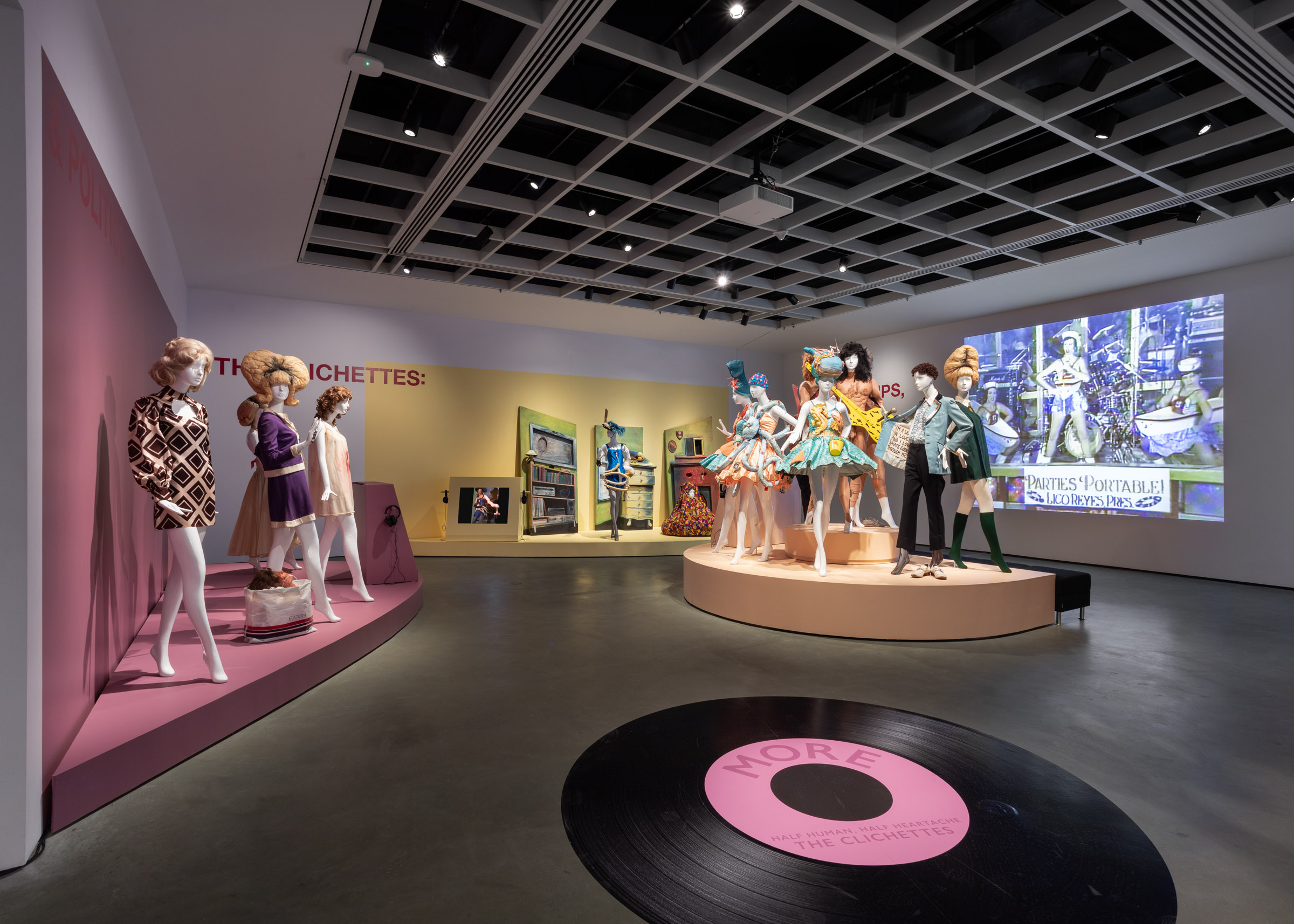Vision Circle: The Art of Roy Thomas
January 8, 2013

The McMaster Museum of Art presents:
Vision Circle: The Art of Roy Thomas
A Retrospective Exhibition
Organized and circulated by the Thunder Bay Art Gallery
Exhibition Curator: Elizabeth McLuhan
On view now through February 23, 2013
Reception: Thursday January 24, 6-8 pm
Panel Discussion: Thursday February 7th, 6 – 8 pm
Ahnisnabae Art of the Woodland School:
The search for a new critical context for First Nations (Aboriginal) Art History
with Ahmoo Angeconeb, Tom Hill, Elizabeth McLuhan and Ruth Phillips and opening remarks by Louise Thomas
“When I use my paintbrush I understand that I am not the only one doing the painting even though my name goes on the finished work.”
– Roy Thomas
Ahnisnabae artist Roy Thomas (1949 – 2004) was one of the leading representatives of what is commonly referred to as the ‘Woodland School of Art.’ Though the career of the founding figure of the school, Norval Morrisseau, preceded Thomas’ debut by almost 20 years, the paths of these two creative giants intersected more than once, throughout their lives. Like many other ‘Woodland’ artists across Northwestern Ontario, the two shared certain commonalities by virtue of regional proximity and cultural origin. Moreover, given the transmission and transference of the style, the work of these two artists spoke to the potency and complexity of contemporary Ahnisnabae visual culture and its pictographic roots.
Roy Thomas is recognized for his contribution on the study of Ahnisnabae art by teaching and mentoring youth, commitment to community and as a driving force in the Mizinatik artist collective.
Earlier initiatives to undertake a retrospective survey of Thomas’ work were thwarted by his terminal illness and premature demise. Thomas was a resident of Thunder Bay from 1989 until his death in 2004. His wife Louise, and their twin boys, Randy and Roy Jr. continue to make Thunder Bay home, where they also operate the Ahnisnabae Art Gallery in Roy’s memory.
Vision Circle: The Art of Roy Thomas constitutes the first critical examination of Roy Thomas’ artistic œuvre and the presentation at McMaster Museum of Art includes more than 40 works from 1965 to 2002. The retrospective recognizes Roy’s contribution to Ahnisnabae painting and the magnitude of his creative vision. The exhibition title encapsulates two recurrent themes in Roy’s work: the visions that shape the fabric of the Ahnisnabae worldview, and the circle, a symbol of inclusion which invites viewers to consider the interconnected richness of Ahnisnabae thought. Vision Circle is also the title of a 1978 acrylic on canvas, which demonstrates the artist’s graphic use of the pictographic lexicon and knowledge of the guiding forces in the Ahnisnabae spirit world.
This project has been undertaken to illustrate, for those less familiar with his work, the unique character of his contribution to the Woodland School of Art, the nature of his achievements, the distinctions that are his and his alone, and to confirm his place in the progress of contemporary Ahnisnabae visual expression.

Guest Curator – Elizabeth McLuhan
In 1984, together with Tom Hill, Elizabeth McLuhan co-curated Norval Morrisseau and the Emergence of the Imagemakers for the Art Gallery of Ontario. AGO Curator of Canadian Historical Art, Dennis Reid, having identified the need for a critical framework on the artistic activity in the province (specifically the Woodland School) approached Hill and McLuhan ‘to evaluate the work of the artists loosely defined as ‘Woodland’ as a phenomenon of the contemporary cultural scene.’
McLuhan and Hill concentrated their efforts on an examination of Norval Morrisseau’s influence as well as that of Daphne Odjig, on artists of the day. This examination was enlivened with the inclusion of five of the most promising artists working in the genre – one of which was Roy Thomas – who were chosen from an estimated seventy-five practitioners working throughout the province.
Over 25 years later, retrospective curator Elizabeth McLuhan has revisited the career of one of these the artists, Roy Thomas, and the impact he and others including Norval Morrisseau in Canadian art history, while also questioning the discursive limits of the term ‘Woodland School of Art.’
Guest Writer – Joseph Boyden
Joseph Boyden’s debut novel Three Day Road (2005) won the Rogers Writers’ Trust Fiction Prize and was followed by Through Black Spruce winner of the 2008 Giller Prize.
The invitation to Mr. Boyden to take part in the project arose from the similarities between the two artists. Both men are storytellers in their own mediums, and both draw from their respective Ojibway heritages for the stories that are deeply rooted in the Ahnisnabae culture of Northern Ontario. Both are mentors to countless aspiring writers and visual artists. Boyden’s contribution to the exhibition catalogue offers a poetic tribute to the life of Roy Thomas.
Publication
Accompanying the retrospective is a 96 page, full colour, hardcover catalogue that includes French and Ojibway translations of essays by retrospective curator Elizabeth McLuhan and Guest Writer Joseph Boyden.
Thunder Bay Art Gallery and McMaster Museum of Art acknowledge the generous support of this exhibition and touring funder and sponsor

McMaster Museum of Art wins Exhibition of the Year for The Clichettes: Lips, Wigs and Politics
December 2, 2025
On Monday, December 1, 2025, Galeries Ontario / Ontario Galleries (GOG) announced the winners of the 48th Annual GOG Awards and the McMaster Museum of Art (M(M)A) took away the top award for the Exhibition of the Year (Budget Over $50K) for the Fall 2024 exhibition The Clichettes: Lips, Wigs and Politics produced in partnership […]

The Creative Process: Well-being through art with the McMaster Museum of Art
August 22, 2025

McMaster Museum of Art Welcomes New Communications Officer Jeff Jung Sing Chow
July 11, 2025





